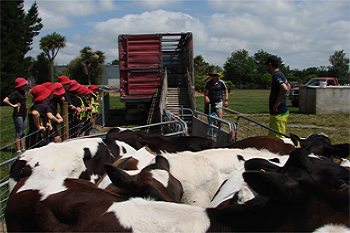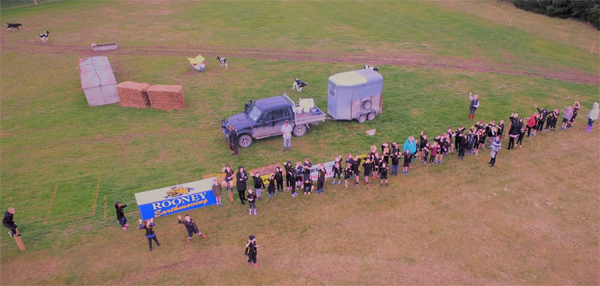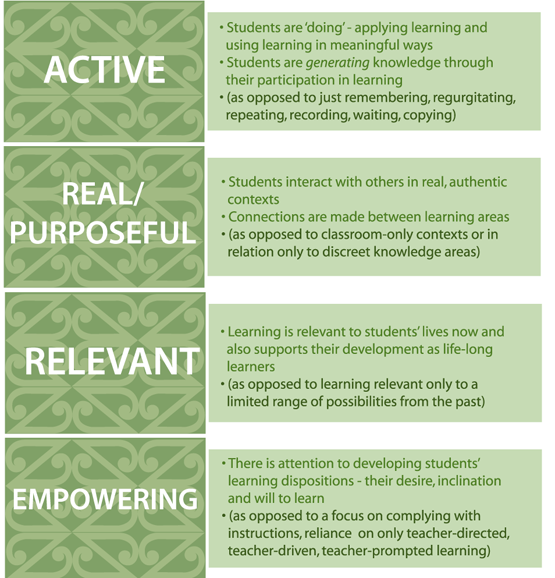Hororata Primary – Discovery learning
A school story describing discovery learning pedagogy and was used to develop Hororata School’s local curriculum design.

About this resource
Marty Gameson, principal of Hororata Primary, shares how discovery learning aligned with their school vision and how it can be applied to improve learning outcomes.
Hororata Primary – Discovery learning
Hororata Primary School, a small contributing school in rural Canterbury, had a strong strategic focus on building their learning culture.
What is discovery learning?
Discovery learning is an exciting, activity-based programme that provides a vehicle for teachers and students to explore curriculum learning and key competency development in an authentic, fun, challenging, and student-directed context.
Discovery Learning Theory is linked to the constructivist/constructivism learning theory work of Jean Piaget and Seymour Papert. It is an inquiry-based practice that takes place in problem solving situations where learners draw on their past experience and existing knowledge to discover facts, and relationships, and new truths to be learned. By empowering a child to take a hands-on approach, the teacher is helping them to think cognitively, creatively, and critically.

Why discovery learning?
As part of the school's self-review process, we identified "equitable coverage" of all learning areas as a significant area of development for the school curriculum. This imbalance saw the 3Rs dominate our curriculum at the cost of other learning areas, and student achievement in these areas declined. To correct this, we promoted learning in science and technology and took deliberate steps towards implementing a blend of Discovery Learning Theory strategies, in particular STEAM (Science, Technology, Engineering, the Arts, and Mathematics), and tinkering learning programmes.
This shift in learning theory saw a pedagogical shift from knowledge to experiential based learning and a redesign of the school’s "learning culture". This, alongside our "active culture," were important ingredients in rebranding our school and giving us a point of difference within our rural learning community.
Discovery learning and the key competencies
"Key competencies are the beating heart of education" – Guy Claxton
...they are the very essence of Discovery Learning.
The key competencies underpin everything that happens in teaching and learning. They have implications for all aspects of planning and teaching, including:
- activities, resources, and language used
- content, topics, or foci for learning
- the role that both students and teachers take in the learning process
- the culture of the classroom and school.

The diagram is a 4x2 table with headings down the left-hand column and information about the headings down the right hand side.
The top left panel says “Active”. The panel beside reads: “Students are doing – applying learning and using learning in meaningful ways. Students are generating knowledge through learning (as opposed to just remembering, regurgitating, repeating, recording, waiting, copying)”
The next panel down on the left says “Real/Purposeful”. The panel beside reads: “Students interact with others in real, authentic contexts. Connections are made between learning areas (as opposed to classroom-only contexts or in relation only to discreet knowledge areas)”
The next panel down on the left says “Relevant”. The panel beside reads: “Learning is relevant to students’ lives now and also supports their development as life-long learners (as opposed to learning relevant only to a limited range of possibilities from the past)”
The bottom left panel says “Empowering”. The panel beside reads: “There is attention to developing students’ learning dispositions – their desire, inclination and will to learn (as opposed to a focus on complying with instructions, reliance on only teacher-directed, teacher-driven, teacher-prompted learning)”
The diagram above identifies four principles that underpin the key competencies and lists indicators to describe what we might see when key competencies are embedded in teaching and learning.
Discovery learning theory aligns well with the key competencies. It:
- puts the learning of language, symbols, and texts into context; gives it relevance and coherence with future learning, and promotes reading, writing, and counting as tools to help students investigate and understand the world around them
- provides students with the opportunity to be creative, critical, and altruistic thinkers who can reflect on their own learning, draw on personal knowledge and intuitions, ask questions, and challenge the basis of assumptions and perceptions
- encourages students to be competent thinkers and problem-solvers actively seeking, using, and creating knowledge and skills
- allows students to manage themselves by being resourceful, reliable, resilient, and striving to achieve their personal best
- allows students to participate and contribute as a group member, to make connections with others, and to solve complex problems.
Discovery learning and the learning areas
The traditional model for delivery of the learning areas is often in silos or through learning experiences that are knowledge-based rather than skill-based. We find ourselves as teachers topping children up with knowledge with little emphasis on the development of skills that are transferred into a child’s life. There is often little coherence between what a child is learning and the application of this new learning in authentic, real-life situations.
Discovery learning effectively unpacks learning backwards, emphasising the development of transferable knowledge and skills. The learning areas are viewed as necessary tools for children to access learning and are applied in authentic, real-world situations.
Discovery learning and the Hororata school vision

At Hororata Primary School, we wanted to encourage our children to "think outside the box"; to use flexibility, creativity, innovation, and social intelligence to solve everyday problems. Our teaching provided children with learning experiences that included elements of developmental, discovery, STEAM, and Tinkering learning theory, with a strong emphasis on science and technology.
Needs and considerations
Learning about science and technology is highly valued by the school and plays a prominent part in the school curriculum.
Learning experiences are designed to provide students with opportunities to apply knowledge and skills, learned through the 3Rs (reading, writing, and arithmetic); and to practice and develop skills in the 4Cs (creativity, critical thinking, communication, and collaboration.)
Learning experiences encourage natural curiosity and enthusiasm and promote exploration, discovery, problem-solving, and creative thinking. Learners become competent users of the basic science process skills: observation, communication, classification, measurement, inference, prediction.
Learning should:
ignite interest in learning (fun)
enhance knowledge and understanding of previous learning (educational)
encourage exploration and discovery through experimentation (hands-on)
build confidence, collaboration, and communications skills (collaboration)
provide opportunities for inventive problem-solving.
The school curriculum was designed around our vision, values, and principles and a metaphoric representation of the Five Pillars of Learning – key competencies. The Five Pillars forged a coherent link between our vision, values, and principles. The essence of discovery learning theory runs through the veins of the school curriculum and is rooted in teaching pedagogy and the school culture.
Hororata discovery learning model
The Hororata Discovery Learning Model provided a real-world relevant context for learning in all learning areas through discovery, enquiry, and exploration, to make learning deep, meaningful, challenging, hands-on, and enjoyable.
The Hororata Discovery Learning Model:
- promotes the key competencies to the forefront of the curriculum
- promotes a stronger focus on the development of transferable essential skills
- provides learners with the opportunity to learn through real-world situations
- provides learners with experiences that have relevance to their learning now and in the future
- strives to make learning meaningful for our students
- acknowledges student diversity by fostering and nurturing students to understand and build on their strengths
- allows students to work independently in their classrooms or with others
- encourages students to build on their interests and develop social and problem-solving skills.
In practice, the (HDL) Hororata Discovery Learning Model:
- is delivered as part of our integrated curriculum (Discovery Time)
- is introduced at all levels of the school through age-appropriate project-based learning experiences, for example, Calf unit, Poultry unit, Horticulture unit
- sees learners involved at all levels of the learning process
- sees teachers engaged as learning facilitators within and across learning projects; for example, teacher expertise will be shared across all projects and is not specific to the area of the school in which they teach
- sees parents engaged as learning partners to work alongside students to undertake some of the more physically and mentally demanding tasks associated with each learning project; for example, construction of facilities, etc
- sees local industry engaged as learning advisors to support students with various aspects of the model, for example, financial, animal health, property development, marketing, etc.
HDL Model Part 1: Strategic thinking
The HDL Model is rolled out in three units. Each unit is mentally and physically appropriate to the targeted age group and has sufficient flexibility to build upon from year-to-year, that is, Discovery learning units: Horticulture unit – junior school; Poultry unit – middle school; Beef unit – senior school (see below for more detail).
HDL Model Part 2: Action planning

A three-by-three grid with each panel in the shape of a puzzle piece
The top left panel says, “Technology, Resource management,” the top middle panel says, “Health, Health and safety,” the top right panel says, “Science, Animal science,”
The middle left panel says, “English, Public relations media,” the middle panel is the title of the diagram and says, “Discovery Learning,” the middle right panel says, “Mathematics, Finance literacy measurement.”
The bottom left panel says, “Science, Plant science,” the bottom middle panel says, “The Arts, Graphic design,” the bottom right panel says, “Technology, Engineering.”
Each component of the HDL model is broken down into three stages:
Stage one – physical environment
The construction component of the project focuses on physically setting up the environment to work in; for example, Calf Unit – feed, fencing, shelter, water. The main contributors to this stage are the learners and their learning partners. One-off cost in terms of money and time (year 1), after which the priority shifts to the maintenance of the facility.
Stage two – support structures
The management component of the project focuses on bringing together all essential resources for the project to operate; for example, sourcing, feeding, caring for, and selling calves. The main contributors to this stage are learning partners and advisors. If managed well in advance, all essential resources will be secured before the operational side of the project commences.
Stage three – learning objectives
The teaching component of the project focuses on translating all management components into learning objectives, effectively engaging students in the management and operation of the project. The main contributors to this stage are learners and learning facilitators. Learning objectives will relate to each piece of the learning jigsaw.
HDL Model Part 3: Sustainability
The greatest risk to the HDL model is that it is a "flash-in-the-pan" and becomes a one off event in the history of our school. For this model to be truly sustainable and have an ongoing impact on learning, it needs to be easily adaptable with strong links to the real world. A longer-term vision of how the model can grow each year is essential as the hype of year one – the establishment year, fades away moving forward.
Beef unit (Years 5–6)
We worked with the Ministry of Primary Industries regarding the impact of Mycoplasma Bovis on the operation of the Beef unit. We received guidance on steps to ensure our unit was safely operated and were given the green light to acquire calves. It is likely that the herd will focus on rearing beef breeds and will see livestock attained through a closed, accredited herd.
Planning is underway for the acquisition of a portable animal shelter, as well as the installation of yards and facilities for the preparation of calf milk. These items will be funded through significant sponsorship attained from Rooney Earthmoving Limited and profit carried over from our 2017 operation.
A sub-committee of students and parents was established with the purpose of bringing all elements of the 2018 plan together.
Poultry unit (Years 3–4)
We worked with advisory groups in the poultry industry to determine the scale of the poultry unit and identify any and all health and safety hazards that we may incur by raising poultry on school grounds.
Planning is underway for the design and build of the poultry enclosure and the acquisition of eggs/ birds to be incubated and/ or reared. These items will be funded by the Board. Our next step is to form a sub-committee of students and parents to take our planning to the next stage.
Horticulture unit (Years 1–2)
We consulted with leaders in the horticulture industry regarding how the unit can be operated within the school and forged strong partnerships with organisations such as the Te Ara Kākāriki Greenway Canterbury Trust (TAK), who support our school by providing education resources and assisting with community planting projects.
Major infrastructure for the Horticulture unit, that is, the tunnel house, seed/plant raising equipment, and gardens, is already in place, with additional funds required to bring the facilities up to standard coming directly from the Board. Our next step is to form a sub-committee of students and parents to take our planning to the next stage.
Benefits of Discovery Learning
Our school curriculum was thoroughly reviewed, and the key competencies were brought back to the forefront of the curriculum. A new direction was established for our school, and the learning journeys of our students were better defined.
The community has embraced the new learning approach, resulting in greater parental and community involvement in our school.
Challenges
Keeping learning at the centre of the conversation.
Implementing a sustainable model.
Achieving the right balance of student and adult input.
To overcome these challenges, we need to remind ourselves:
- it's not about raising money for our school
- it's not about growing the next generation of young farmers
- it is is about providing our children with authentic, real world learning experiences.
Where to next
The Discovery model will continue to focus on the development of the key competencies through authentic learning experiences delivered through developmental, STEAM, Tinkering, and discovery learning pedagogies.
To achieve a consistent approach to the delivery of Discovery in our school, we introduced Discovery Time into the timetable. During this time, all levels of the school work on discovery-based activities in mixed-ability groupings. The key learning areas of beef/ bird/ horticulture within the Discovery Learning model will continue to be rolled out as originally planned, with the goal of all infrastructure being in place by the end of 2018.
Thinking of "discovery" in its broadest sense, "becoming aware of something that you did not know about before". The Discovery Learning model can be applied across the curriculum, whether it is discovering something new about yourself, or about the world around you. The HPS discovery model is merely a vehicle to initiate teaching and learning in the discovery space. With the key competencies, 3Rs (reading, writing, and mathematics) and 4Cs (creativity, critical thinking, communication, and collaboration) held firmly at the forefront of our thinking it has unlimited potential.
STEAM and the three contextual themes, that is, beef/ bird/ horticulture, have been used merely to reign in our thinking in this space, so we establish strong sustainable foundations and a learning culture.


